If you’re looking for a way to keep your holiday turkey extra juicy and flavorful, this buttermilk brined turkey breast is the secret you’ve been waiting for. With a simple brine made from buttermilk, herbs, and spices, this recipe infuses every bite with rich flavor and tenderness. It’s the perfect centerpiece for Thanksgiving or any special gathering, and once you try it, you might never roast poultry without a brine again.
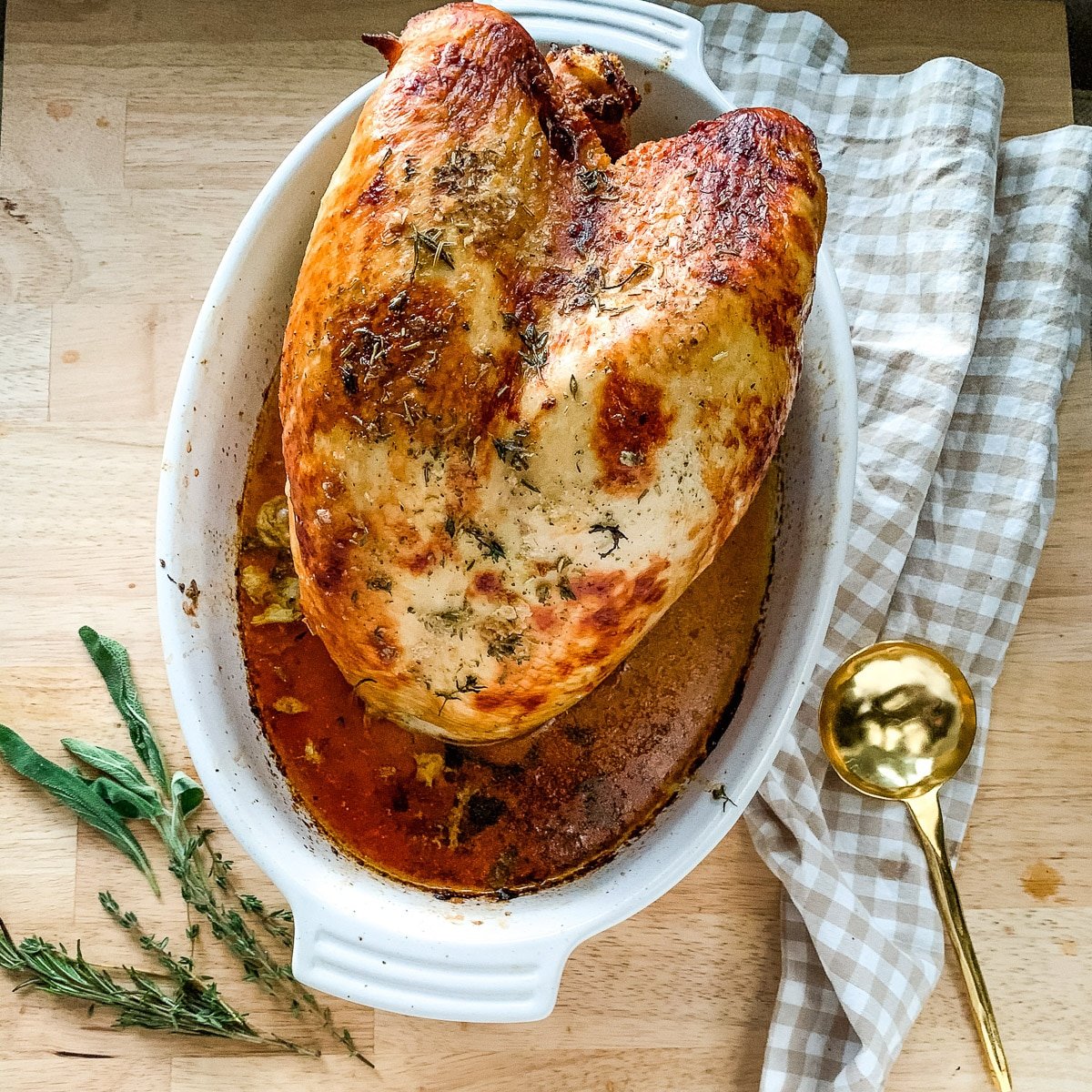
For smaller holiday meals or intimate gatherings, choosing a breast instead of a whole bird makes sense—less stress, less space, and a much quicker cook time. That’s where a buttermilk turkey brine comes in handy. It delivers big, bold flavor without needing a full-sized turkey or complex prep.
Brining isn’t just a trend—it’s a technique that transforms poultry. The salt in the brine seasons the meat from the inside, while the buttermilk’s natural acidity and calcium help tenderize it. This results in turkey that’s not only flavorful but also moist and easy to carve. Many cooks consider it the best turkey marinade for texture and taste.
One of the standout benefits of using buttermilk is the golden, crisp skin it produces during roasting. Thanks to the natural sugars in buttermilk, you’ll get that picture-perfect, bronzed exterior without extra effort. And best of all? The process is surprisingly simple. You just need a large container, a sturdy brining bag, and a few pantry staples to pull off a show-stopping holiday meat with very little cleanup.

Content Covered Here
Why We Love The Best Turkey Marinade
- Less waste for smaller families.
A full-sized turkey can sometimes be too much food for smaller households, leading to leftovers that don’t get eaten. By brining and roasting a smaller meat, you can still enjoy the classic holiday flavors without worrying about excess food going to waste. - Takes up less space in the oven.
Traditional whole turkeys take up a lot of oven space, making it difficult to cook side dishes at the same time. A smaller, brined turkey cooks faster and allows you to maximize oven space, so you can bake casseroles, stuffing, or desserts while the turkey roasts. - A budget-friendly option when money is tight.
Turkey prices can be high during the holidays, especially for large birds. Using this buttermilk turkey brine on a smaller, more affordable cut (like a breast or smaller whole turkey) allows you to enjoy a flavorful, tender turkey without overspending. It’s a great way to serve a delicious meal while keeping grocery costs under control!
Ingredient Notes and Substitutions

- Seasonings: the seasonings in brines help infuse added flavor, beyond salt. And, It’s okay to use whole herbs, like bay leaves, since it’s drained like marinade and discarded. We recommend basil, coriander seed, peppercorns, mustard seeds, and garlic, but you can substitute them with your preferred herbs and spices.
- Buttermilk: I don’t recommend using a substitution for buttermilk. Adding vinegar or lemon to milk will not have the same effect in this buttermilk turkey brine. You can use 2% milk fat or non-fat.
- Salt: You can use any type of salt, but I prefer Kosher salt for a few reasons. First, the sodium level is consistent. Another reason is it comes in a box, so I always have enough on hand in the pantry. If you use sea salt or table salt, use 1 cup as a substitution. Kosher salt is less dense.
A breast is about 6-7 pounds, the ideal size for this buttermilk brine recipe. See the recipe tips below to learn how to brine a whole turkey!
Recipe Variations
- Herb-infused: Add fresh herbs like rosemary, thyme, sage, onion, fine sea salt, and parsley to the buttermilk brine for an extra boost of flavor. You can also mix in garlic cloves, lemon zest, and black peppercorns for even more depth.
- Spicy cajun turkey breast recipe: For a Southern twist, add Cajun seasoning, smoked paprika, cayenne pepper, and a splash of hot sauce to the buttermilk brine. This version pairs perfectly with cornbread stuffing and roasted sweet potatoes!
- Roasted with citrus: Add fresh orange and lemon slices to the brine for a bright, citrusy twist. This variation works well with honey-glazed carrots and cranberry sauce for a well-balanced holiday meal.
- Smoked: Instead of roasting, smoke the brined turkey for a deep, smoky flavor. Use hickory or applewood chips for a rich, slightly sweet smokiness that enhances the buttermilk seasoning.
- Garlic and black pepper: Increase the garlic and black pepper in the brine for a bold, savory twist. This variation pairs well with mashed potatoes and creamy gravy for a classic comfort food meal.
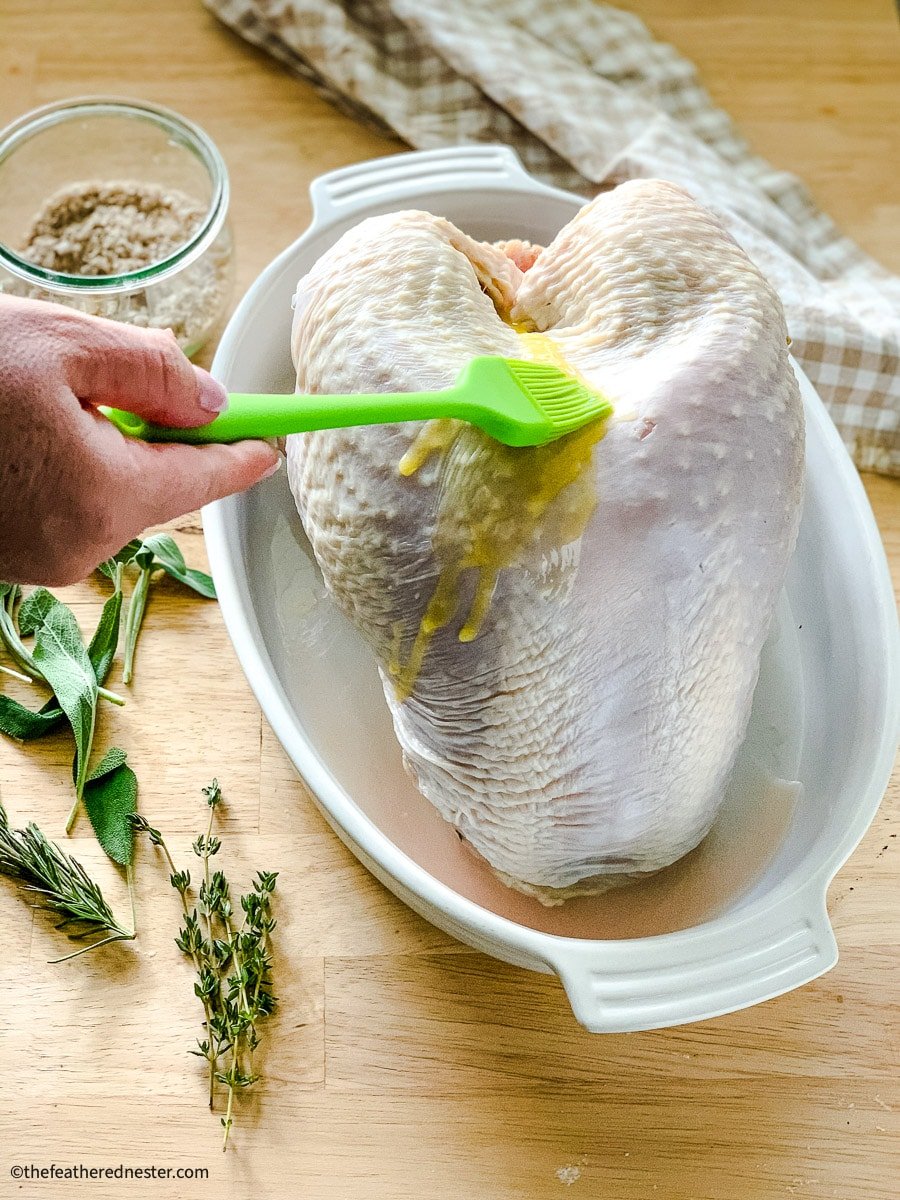
Equipment Used in this Recipe
- Large saucepan
- Heavy-duty brining bag – about 4 gallons
- Tall stock pot or bowl – about 12 quarts
- Basting brush
How to Make Buttermilk Turkey Brine
- Start early!
- Brining takes at least a day. Plus, it takes a few hours for the brine mixture to cool. So, if you need 3 days to thaw your poultry, add a day to the process. If you have a frozen turkey, see our recipe tips below.
- Submerge the meat completely. Use a tall stock pot or bowl to help the turkey breast stay covered with brine.
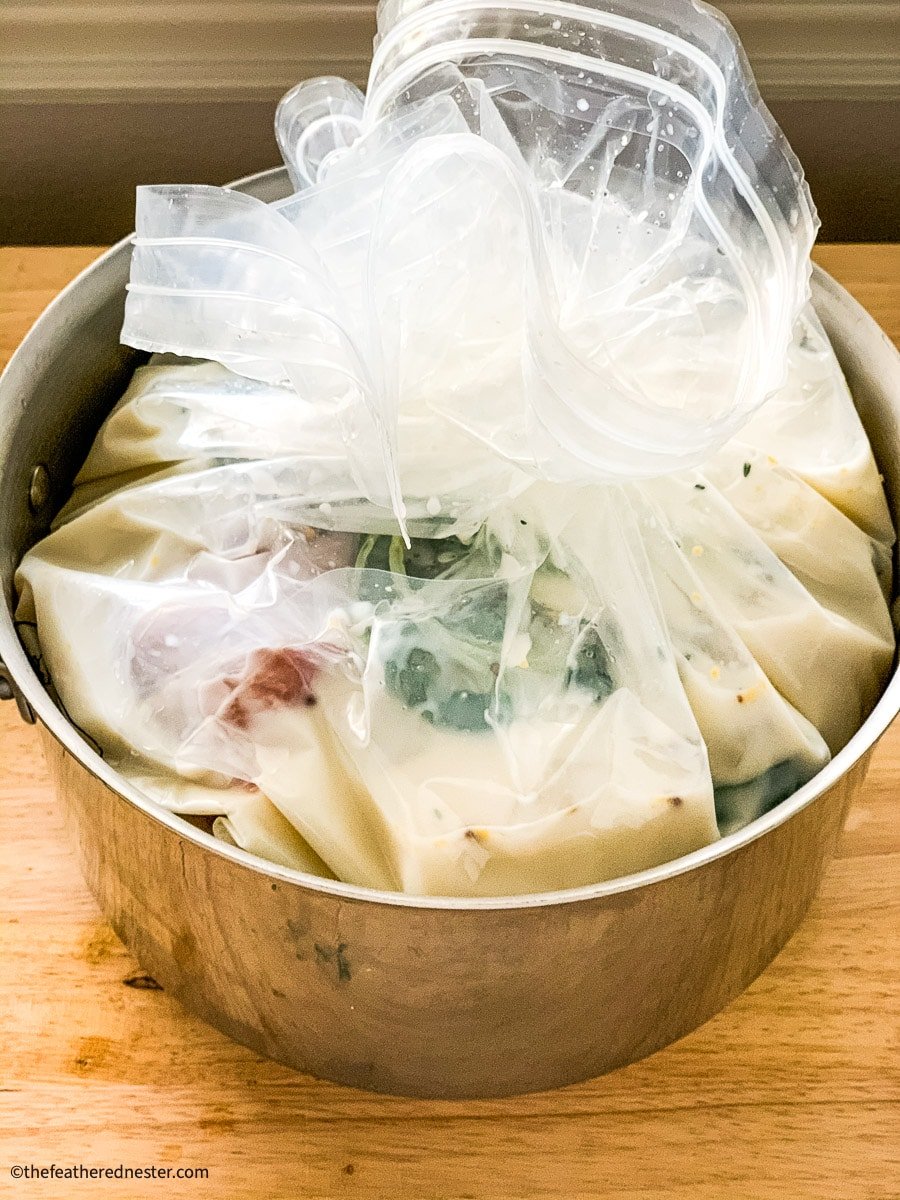
- Rinse off the brining mixture and let air dry before roasting.
To avoid overly salty poultry, remove it from the brine and rinse it thoroughly. Then, pat it dry with paper towels. Be sure to let it air dry for at least 15 minutes. Moisture will prevent getting that crispy, deep golden hallmark of the perfect roasted bird.
🎯 TFN Pro Tip
Thawing first isn’t essential. If your breast is frozen, you can thaw while brining. Give it an additional day to defrost and brine in the fridge. So, plan for a total of 36-48 hours.
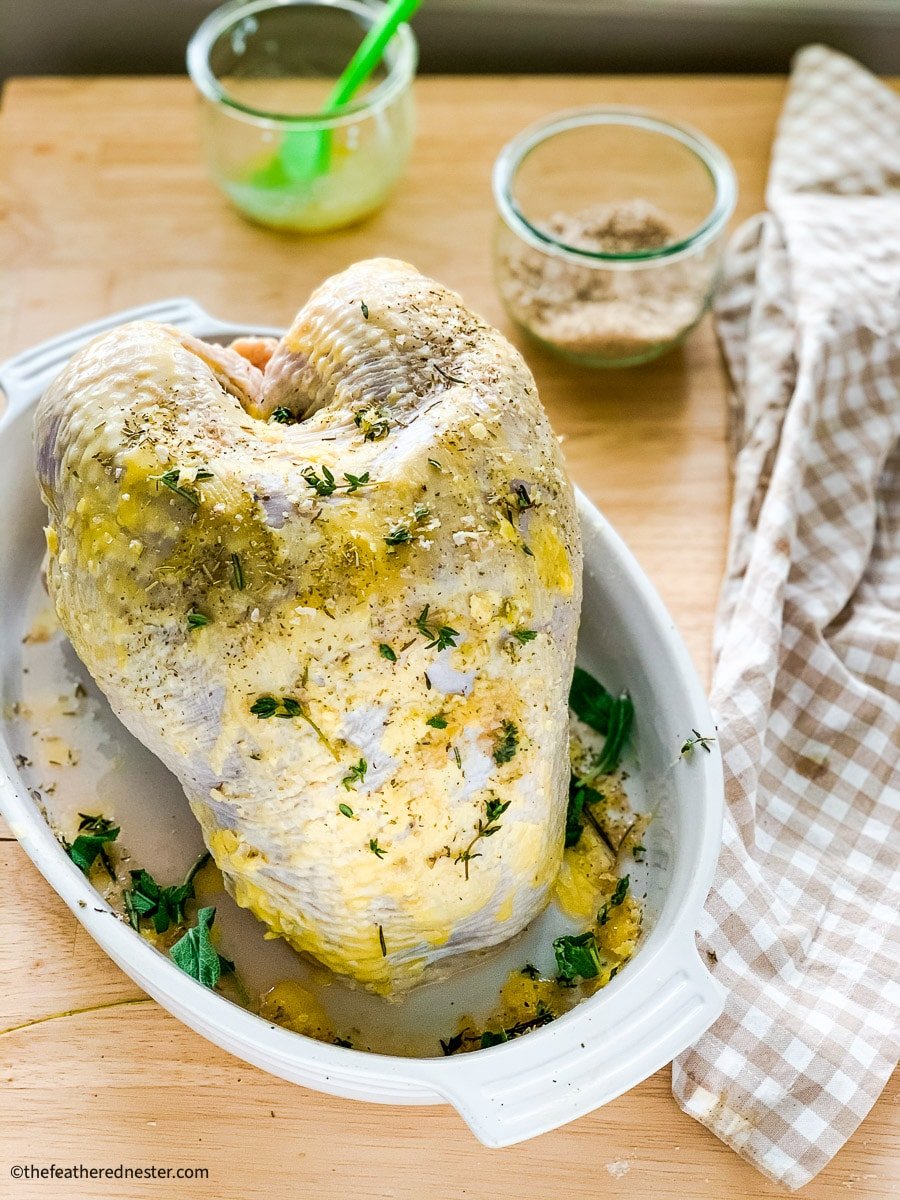
- Let the poultry rest before carving.
Allow your buttermilk brined turkey breast to rest on the serving platter or a carving board before slicing. This lets the juices redistribute. If you cut it right away, the juices will run out leaving the meat drier.
🎯 TFN Pro Tip
Double the recipe for a full-sized turkey. This recipe makes about 1-1/2 gallons of brine, perfect for an average-sized roast. For a medium-sized bird (12-15 pounds), double the recipe.
Serving Suggestions
This buttermilk brined turkey breast pairs beautifully with a variety of classic holiday sides and comforting dishes. The tender, juicy turkey with its subtle tangy and herby flavor complements both savory and sweet sides, making it the perfect centerpiece for any meal.
For a traditional holiday spread, serve it with fluffy mashed potatoes, turkey gravy, and homemade stuffing. A side of roasted Brussels sprouts, honey-glazed carrots, or green bean casserole adds color and texture to the plate. If you love Southern-style comfort food, pair your turkey with cornbread dressing, sweet potato casserole, and creamy mac and cheese for a hearty and satisfying meal.
For lighter and more refreshing options, serve it alongside a fruit in jello, roasted butternut squash, or a citrusy arugula salad to balance the richness of the turkey. If you’re planning for leftovers, slice the turkey and make turkey sandwiches with cranberry sauce, turkey and rice soup, or even turkey tacos the next day!
No matter how you serve it, this recipe will be the star of your table, delivering incredible flavor in every bite!
Recipe FAQs
I think so! Although not scientific, over the years we have served both brined and non-brined turkeys and those brined typically turn out tastier and juicier.
No, it is optional. But, if you like flavorful, juicy poultry or pork, I recommend taking the time to brine it. The last thing you want your guests to remember is how dry or tough the main entree was on Thanksgiving or family dinner.
Yes, but be sure to pat the turkey completely dry before frying. Any excess moisture can cause oil splatters. For safety, let the turkey air dry for at least 30-60 minutes before frying.
Store leftovers in an airtight container in the fridge for up to 4 days. To keep the meat moist, reheat in the oven at 300°F, covered with foil, or warm in a skillet with a splash of broth.

Consider Making These Other White Meat Recipes…
If you tried this best turkey marinade recipe or any other recipe on my website, please leave a 🌟 star rating and let me know how it went in the 📝 comments below. Thanks for visiting!
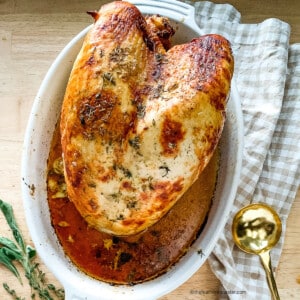
Buttermilk Brined Turkey Breast
Equipment
- large saucepan
- heavy-duty brining bag - about 4 gallons
- tall stock pot or bowl - about 12 quarts
- basting brush
Ingredients
Buttermilk Turkey Brine
- ¾ cup kosher salt *see recipe notes below for substitutions
- 5 tablespoons dried basil
- 5 tablespoons coriander seeds
- 2 tablespoons black peppercorns
- 2 tablespoons yellow mustard seeds
- 5 cloves garlic , crushed
- 4 bay leaves
- 4 cups water
- 1 gallon (4 quarts) buttermilk
Turkey Breast
- 1 bone-in turkey breast (about 6-7 pounds)
- 2 tablespoons melted butter
Instructions
- In a saucepan over high heat, combine the salt, basil, coriander, peppercorns, mustard seeds, crushed garlic, and bay leaves with the water and bring to a boil. Stir occasionally, until salt is dissolved. Remove from the heat and let cool to room temperature.
- In a large pot or bowl, stir together the cooled mixture and buttermilk. Rinse the turkey with cold water and place it in a large heavy-duty brine bag. Carefully pour the buttermilk brine into the bag. Seal the bag, pressing out the air, and place it in a large, tall stockpot or another container large enough to hold the meat and keep it covered with the brine. Refrigerate for 24 to 36 hours, turning occasionally.
- Preheat oven to 325º F.
- Remove the poultry from the brine and rinse it with cold water. Then pat dry with paper towels. Let it stand at room temperature to air dry for 15 minutes before roasting.
- Brush the skin of the meat with melted butter and place it in a roasting pan or casserole dish. Roast at 325ºF for 15 minutes per pound. Use an instant-read thermometer to check the internal temperature of the center of the breast (avoiding bone) until the center of the poultry roast is 165º F.
- Remove the roast to a platter or carving board. Cover with foil and let rest for 25 minutes before carving.
Notes
- Herb-infused: Add fresh herbs like rosemary, thyme, sage, and parsley to the buttermilk brine for an extra boost of flavor. You can also mix in garlic cloves, lemon zest, and black peppercorns for even more depth.
- Spicy cajun: For a Southern twist, add Cajun seasoning, smoked paprika, cayenne pepper, and a splash of hot sauce to the buttermilk brine. This version pairs perfectly with cornbread stuffing and roasted sweet potatoes!
- Roasted with citrus: Add fresh orange and lemon slices to the brine for a bright, citrusy twist. This variation works well with honey-glazed carrots and cranberry sauce for a well-balanced holiday meal.
- Smoked: Instead of roasting, smoke the brined turkey for a deep, smoky flavor. Use hickory or applewood chips for a rich, slightly sweet smokiness that enhances the buttermilk seasoning.
- Garlic & black pepper: Increase the garlic and black pepper in the brine for a bold, savory twist. This variation pairs well with mashed potatoes and creamy gravy for a classic comfort food meal.
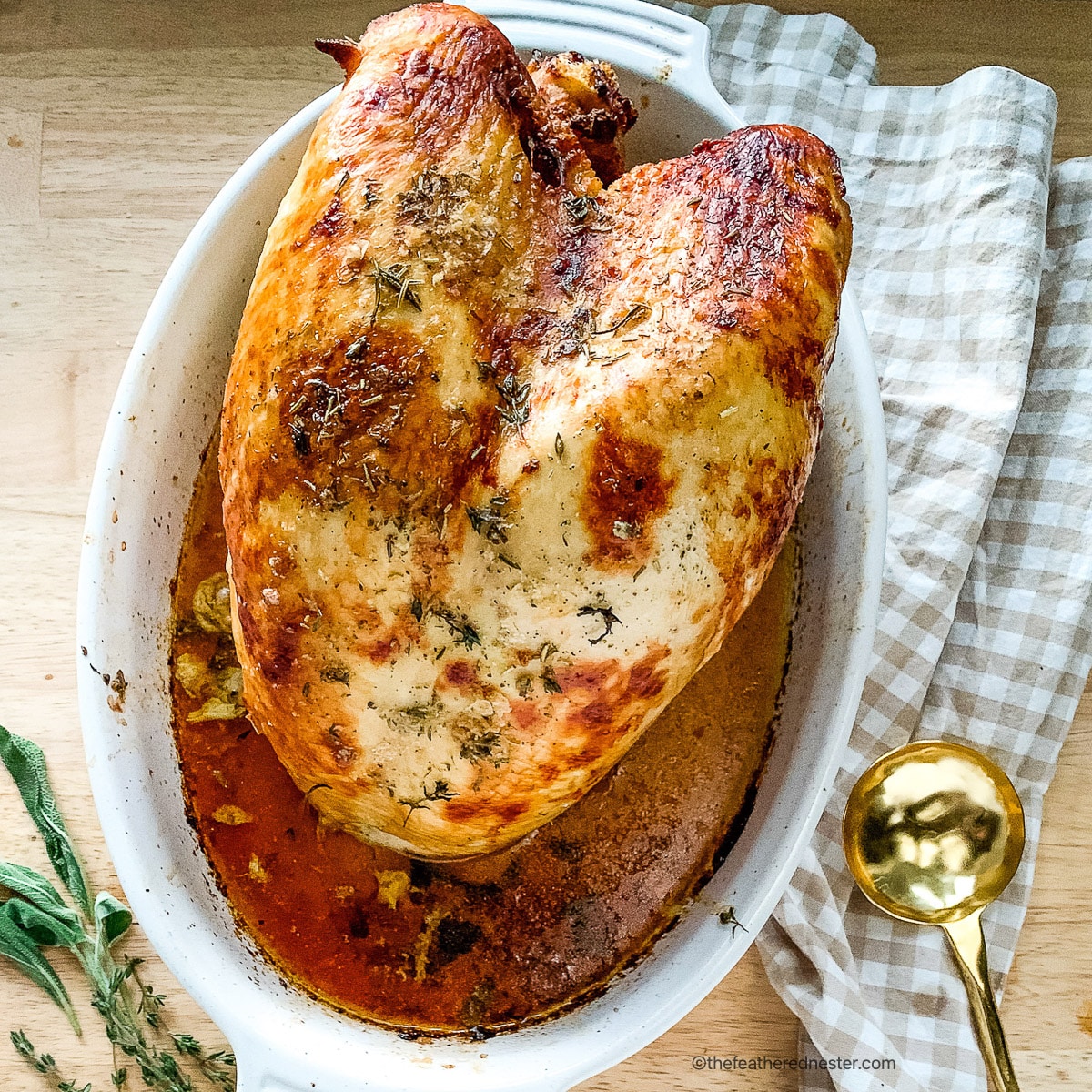

Andrea says
Thank you for the explanation as to why Brining a turkey makes it so tender and delicious. I love all the seasonings you used in this brine and I will definitely be trying this for the Holidays.
Amy Desrosiers says
This is my favorite cut of the Turkey. I know my family is going to enjoy this since we’re not into dark meat.